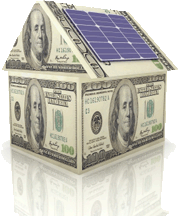 As I have said before there is deliberate bearishness about solar power, much of it coming from the fossil fuel industries.
As I have said before there is deliberate bearishness about solar power, much of it coming from the fossil fuel industries.
They deliberately ignore the basic economics of the trade. Install a capital good now and money comes out, day-after-day, year-after-year, literally for decades. Regardless of the current price of grid electricity you will, in time, pay for that capital good and generate a positive return. As grid prices rise, the deal gets better. As panel prices fall the deal remains just as good.
As I wrote before, Solyndra was actually a good deal. They promised costs 35% below the market. They were worth the investment. The “problem” was that costs fell a lot more than that, due to over-production in China. This created a glut that now has panels selling below their production costs.
Problem? No, opportunity.

Technology has to change to deal with lower costs for competing technologies. Solar heating systems like Ivanpah need innovation to become viable. Fine. Brightsource brings in energy storage with molten salt, reducing the necessary size of the project, and we move on.
Whatever happens to panel prices and yields, there are many other ways to save money, to reduce costs, and to increase returns on solar investments. One way is by putting inverters – DC-AC converters – on each panel, making them plug and play. This is the business of (among others) Enphase Technologies, which just raised another $8 million for micro-inverter production and is aiming at an IPO.
Another way forward is to cut channel costs, standardizing contracts not just on the high end and low end, but in the middle market. I know people in that game, who are doing just what companies like Tioga Energy have tried to do – cut paperwork costs. You standardize contracts, you standardize approvals, you lower the cost of selling systems and the friction involved in financing them, you make the whole system more efficient. You lower costs, shorten the time to a positive return on investment, increase the size of the market. No technology needed.
Nor is the technology remaining static. Here a few recent headlines:
-
Stanford graduate student Colin Wessells (right) has authored a paper describing how copper hexacyanoferrate, a nano-particle derived from Prussian Blue, can deliver batteries that recharge tens of thousands of times without failing. You say solar has storage problems? I got your storage problems right here.
-
HyperSolar says it can produce natural gas directly from solar power. Turning solar power into something we already know how to use eases the transition to renewable power in vehicles.
-
SageGlass adjusts its color on-demand, meaning buildings can use less energy, absorbing heat and light when that's efficient, reflecting it when that's efficient.
-
Taiwanese scientists are using porphyrin as a sort of “artificial chlorophyll to increase the solar power yield of current technologies by 20%.
-
Sharp has used a stacked three-layer structure to create a solar cell with a yield of 36.9%. This was done by reducing the resistance between the layers of the cell. Now they just have to get this into mass production.
Each and every time I look at this field, I find breakthroughs like this. I seldom find I have to repeat myself, and the process of researching these breakthroughs takes just a few minutes on Google News.











I was highly excited to have read your article. I have found here many interesting things. Just what I need. Thanks for sharing it.
I was highly excited to have read your article. I have found here many interesting things. Just what I need. Thanks for sharing it.
Great ideas to ponder and practice.
Great ideas to ponder and practice.